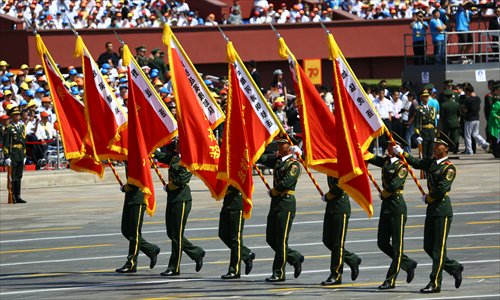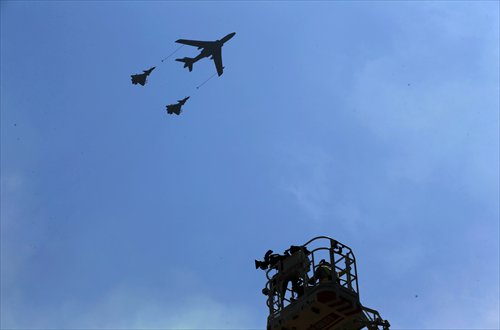How WWII parade displayed China’s past, future

Soldiers march during a parade in Beijing on September 3 to mark the WWII victory. Photo: Zhang Siyang/GT

PLA aircraft fly over the parade. Photo: Cui Meng/GT
The Tiananmen Rostrum looked a bit surreal on the early morning of September 3.
The sun was about to rise, giving the dark blue sky a tinge of orange from the east. The street lamps were on and Changan Avenue, Beijing's busiest street, never looked so empty.
It was 5:32 am when I arrived, along with a bus full of reporters, at the very center of Beijing to begin my coverage of the military parade that celebrated the 70th anniversary of World War II.
Every intersection was blocked by police cars to prevent any disruption of the parade. National flags were seen flying on rooftops of the buildings along the street.
To the east of the rostrum, soldiers were already lining up in their formations. Some were taking a last moment to perfect their goose stepping, shouting slogans as they practiced.
One formation of soldiers stood at attention and listened as their commissar reminded them of the responsibility laid on their shoulders; their performance today would decide how the Chinese army is seen in the eyes of the world.
As dawn broke, tanks, missiles and other military equipment began to reveal their silhouettes against the backdrop of the rising sun. Much of the new weaponry had never been shown to the public before. The acrid smell of exhaust rose as diesel-burning military trucks rolled past. The weapons on display formed a line so long that it appeared to stretch endlessly down East Changan Avenue.
There was something so formidable about the scene that I found myself lost for words.
On heels of reform
Months later, while recalling my experiences at the parade, I wonder if history would remember it as marking the beginning of a new era for the Chinese military.
At the parade, Chinese President Xi Jinping announced that the People's Liberation Army (PLA) would be cut by 300,000 personnel by 2017.
Two months later, a more detailed guideline for reforming the PLA was released - the army-centric old system would be replaced by a joint command where army, navy and air force are equally represented.
The four headquarters, General Staff, General Political, General Logistics and General Armaments, will be reorganized and the seven military commands will be rezoned.
The Central Military Commission will strengthen its command structure and impose stricter discipline on the military.
The reform, dubbed by media as a "game changer," followed a nationwide anti-graft campaign, increased anti-terror missions and rising tensions in the South China Sea.
Two former Central Military Commission vice chairmen, Xu Caihou and Guo Boxiong, were investigated for corruption charges in the past two years. Xu died of cancer in March this year while awaiting trial.
China is also facing growing challenges in the South China Sea, as well as terror threats both domestically and abroad.
Many analysts see the military reform as not only necessary, but also long overdue. The highly-anticipated reform will meet the changing demands at home and internationally, said experts, with some pointing out with urgency that if China misses this window of opportunity, it will lose the chance to upgrade its military.
They also warned of the difficulties in carrying out the plan.
According to a report by Phoenix Weekly, a Hong Kong-based magazine, the reform guideline was postponed at least twice since late 2014.
The reform plan was said to have touched on the interests of multiple stakeholders.
About-facing challenges
Looking back, the September parade was already mired in controversies before it even started. Western media had been questioning whether the parade was aimed at Japan or if China intended to flex its muscles at the event to "scare off" its opponents in the South China Sea dispute. Media also guessed as to which country would "side with China" and attend the parade.
Despite criticism and cold shoulders from the West, the parade was received warmly at home.
Many on social media took the chance to pay tribute to soldiers that had fought in World War II. Veterans from the Kuomintang (KMT) Party were invited to attend the parade, a cross-Straits gesture of peace and acknowledgement of the KMT's contributions to the war effort.
Many Chinese also took pride in their nation's growing strength.
One of the most popular Weibo posts on September 3 commemorated the former Chinese premier Zhou Enlai, who 66 years ago ordered planes to fly twice over Changan Avenue because China simply did not have enough aircraft to complete the parade during the founding ceremony of the People's Republic.
"Today we have as many planes as we want. A country of prosperity, just like you had wished," the post read.
Netizens used the national flag as their Weibo avatar. Some of those invited to watch the parade at Tiananmen Square painted the flag on their faces.
The vastly different opinions on the parade at home and abroad reflect the complex situation China faces.
Some foreigners I spoke to questioned whether a parade is the best option to demonstrate China's devotion to peace, suggesting rather to hold a ceremony remembering the war victims or events with more public participation.
But many Chinese believe a military parade is necessary for their country, which has a tradition of holding solemn rituals to inspire its people. They see parades as part of a greater heritage that has been handed down from the founders of the republic.
Read more in Special Coverage:
Newspaper headline: Forward strides